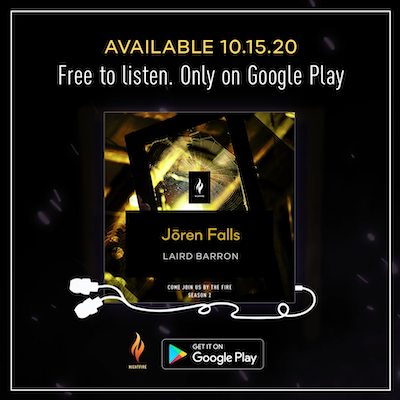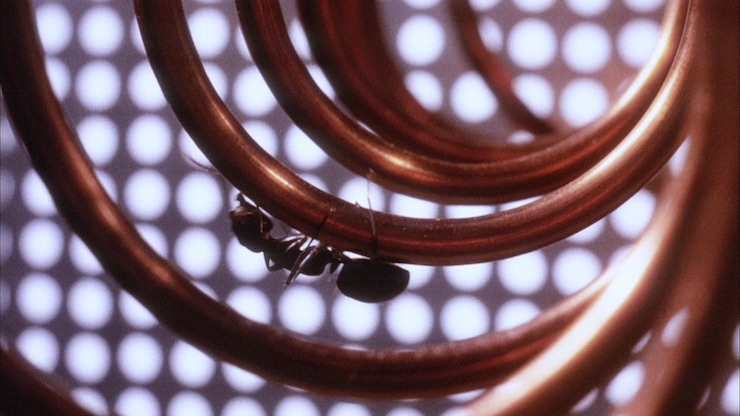sample heading
To celebrate the release of the second season of Come Join Us By The Fire, our audio horror anthology, we’ve asked authors with stories included in this year’s anthology to join us and write about horror. Below, Laird Barron, whose story “Jōren Falls” you can listen to here, writes about identifying and digesting influential books and movies, and how to train your muse.
For me, craft begins and ends with influence and inspiration. The bedrock of my process is to capture ideas. Useful ideas are elusive and fleeting entities. I’ve come to regard their acquisition as analogous to lying in a blind with a telephoto lens awaiting the entrance of some furtive creature. What I wind up doing with those ideas owes everything to my influences.
In the case of “Jōren Falls,” the basic premise originated this spring as I toiled on an essay in my home office. A commotion broke out in the attic, followed by chunks of plastic, bits of insulation, and other detritus sailing past the window. I soon discovered a squirrel had bored its merry way through the wall and set up shop in the rafters. This tale ended happily—later that week, a carpenter replaced the attic vent with a nice sturdy aluminum model. Meanwhile, the squirrel ceded defeat and scampered off into the forest. Even as the carpenter repaired the damage, I’d already made notes in the big file. “Jōren Falls” chronicles a darker, alternate universe version of events. My apologies to the fictitious carpenter who inhabits that realm.
While amusing, a squirrel incursion isn’t particularly remarkable so far as bolts from the heavens go. To consistently succeed as a fiction writer, relying on spontaneous ideas isn’t always enough. However, I learned an important lesson from my friend and comrade, John Langan. He holds that one’s subconscious can be trained to generate stories from the mildest prompts if one cultivates the talent. He described the subconscious––our imagination––as an eager-to-please puppy who fetches random and often useless items when all you want is to teach him the trick of retrieving a specific object. You don’t reject or admonish the pup when he drags in a root clod instead of your slippers, or if the morning paper is half-mangled. Dismissal and impatience have the negative effect of stunting enthusiasm, of breeding inconsistency. Instead, you praise the little scamp when he brings you unwanted presents, and kindly but firmly redirect him toward the real goal. With sufficient patience and development, that dog will eventually become attuned to your wishes. John puts it more elegantly than I have. That’s the gist, though. The principle has served me well enough that a portion of my work regimen is devoted to the notion of maintaining my muse. To this effect, there’s a massive file on my hard drive of dialog, scenes, quotes from news articles, snatches of overheard conversations, dream vignettes, and fragmentary scenes. I’ve built this “idea” file over the past decade—it remains open whenever I’m working. Many of those ideas remain in permanent stasis. Others I develop and assemble the disparate elements with as few exposed seams as possible.
Jump forward a few months after the squirrel incident and I’m attending a video conference with editor Ellen Datlow and several author colleagues. Speaking about our contributions to Ellen’s anthology devoted to the dark side of cinema, someone raised the subject of influence. One author noted that, broadly speaking, for good or ill, contemporary horror literature is intertwined with horror films and TV shows, especially as a cultural touchstone. Everyone agreed, citing personal movie favorites. The conversation got interesting when we began batting around the function of literature versus film—where the mediums intersect, where and how they diverge, and what each does that the other cannot.

Christopher Golden’s reminiscence about the 1954 killer ant movie, Them!, struck a chord. He described the opening scene, a little girl wandering, bereft and terrified, and how her affect grounded the absurdist nature of the story, lent it emotional authenticity. Golden spoke of trying to recreate that kind of cinematic effect on the page. It occurred to me, and not for the first time, that essentially, writers are always struggling with the problem of translating what we see, hear, and feel into words. Whether we’re translating from another discipline or from lived events, it’s a challenge to achieve even a semblance of the imagery as it exists in our mind’s eye.
A relevant aside gleaned from the conversation: with each passing year, more folks come around to the weird magic of John Carpenter and his films, The Fog and The Thing. And a further aside, much as I adore those movies, my aesthetic was probably most profoundly affected by another seminal ant-horror flick, Saul Bass’ Phase IV, if for no other reason than that I saw it at age five or so. It’s a testament to Bass’ genius for directing that, revisiting Phase IV decades later, I realized my child-self had grasped the essential beats of the story despite the screenplay’s prodigious leaps of narrative logic and its borderline incoherency.
Some writers doggedly reject overt influence as a corruptive force. Others embrace their influences, which is often expressed as replication or hybridization. Josh Malerman noted a growing trend in contemporary horror literature mimics film technique to the degree that certain novels read as quasi-screenplays. But there’s another potential result of influence—one sees a thing and that thing becomes embedded in one’s subconscious. Artists tend to operate as filters rather than creators of wholly original content.
Influence mutates in complex ways, yet reduced to its essence, “you are what you eat” holds true. Ufology was a big deal in 1970s USA—my formative childhood years. An impressionable demographic, including close relatives, exhibited a paranoid obsession with the Fortean and the occult. Crop circles, cattle mutilation, alien abduction, Sasquatch. News stories and faux documentaries gave rise to a slew of questions: were your neighbors Satanic cultists? Moles installed by the KGB? I was too young to elect for the Phase IV mind-warping, or the Fortean craze, or the Satanic Panic/Cold War paranoia, but these are experiences I attempt to channel as an adult. I subscribe to the belief that it’s best to absorb from artists whose careers most resemble what I’d love to have for myself. The concept is similar to training one’s muse. Obviously, there’s much beyond our control, yet to the extent that we control anything, we routinely choose our authors, our filmmakers, our musicians, and so on. Grain by grain, these selections gather weight over a lifetime. They ultimately define us, as much, if not more so, than the mechanical process of forging art, of refining a voice, or perfecting a technique.
As the Grail Knight once said, choose wisely.
Laird Barron, an expat Alaskan, is the author of several books, including The Imago Sequence and Other Stories, The Croning, Swift to Chase, and Blood Standard. Currently, Barron lives in the Rondout Valley of New York State and is at work on tales about the evil that men do.
Listen to Laird’s story “Jōren Falls” on Google Play here, and listen the the entirety of the second season of Come Join Us By The Fire here.




This sounds great. Sadly (ironically?), it does not appear to be available here in Japan. Season one is similarly region restricted. Any chance of changing that?